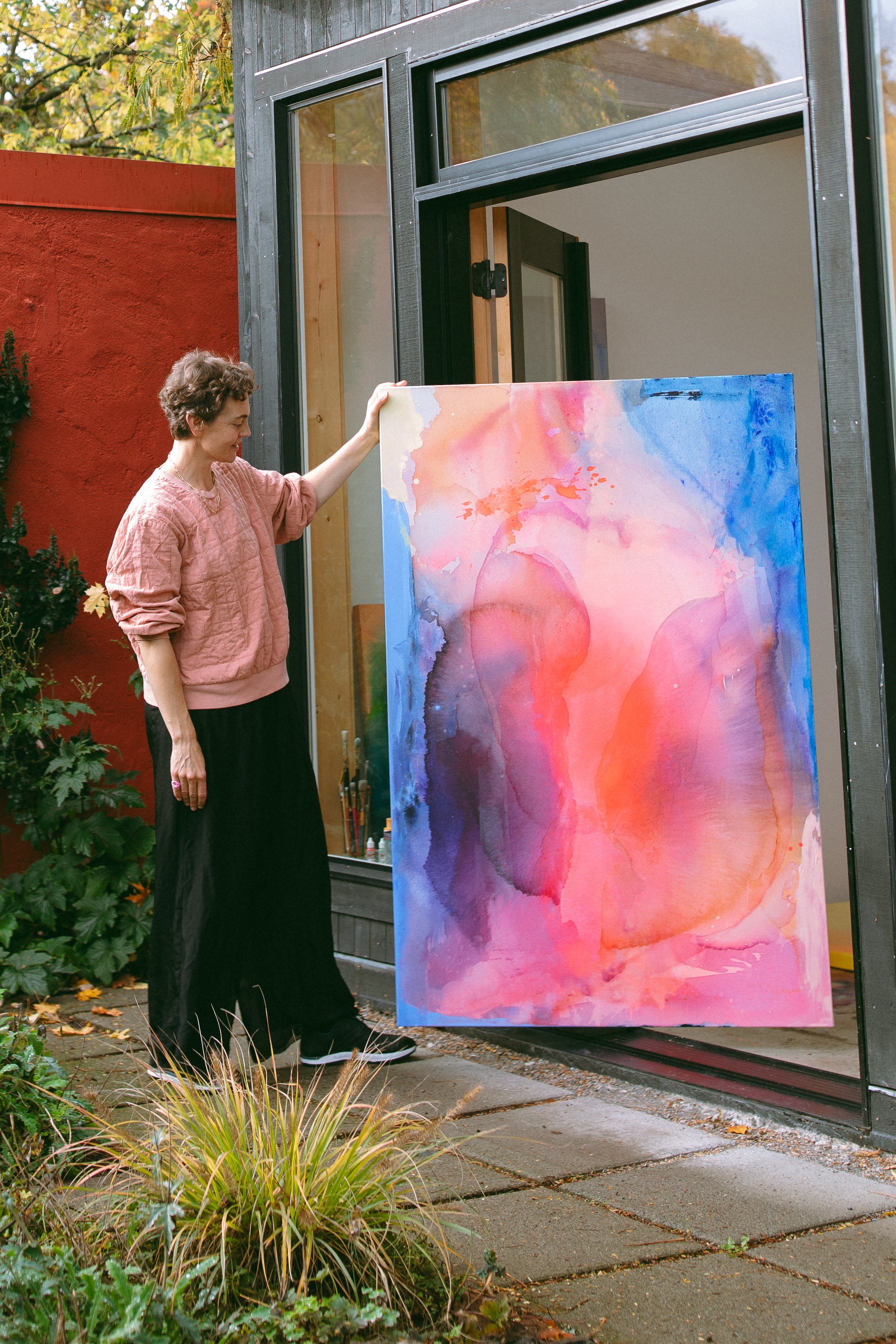Beyond the Canvas:
Aremy Stewart on Abstraction,Interiors, and the Art of Belonging
Photography by
Portland-based artist Aremy Stewart is known for her bold, abstract acrylic paintings — works that pulse with movement, color and a deep connection to the natural world.
But her journey didn’t start with abstraction. Before moving to Portland in 2016, Aremy was dedicated to realism, honing her ability to recreate objects with near-photographic precision. The shift to abstraction came like a creative reset, fueled by the energy of the Pacific Northwest and its vibrant art community.
In conversation with SOULBASE, Aremy reflects on the relationship between art and interior spaces, the personal nature of commissioned work and how seeing one of her paintings in a stranger’s home sparked the same feeling as unexpectedly bumping into a family member. She also shares insights on the transformative power of color, the joy of working with collectors to create bespoke pieces and the dream commission she hopes to bring to life one day.
Aremy, as an artist based in Portland, Oregon, could you briefly describe your art style and vision? How has living in Portland shaped your style? I make big, abstract acrylic paintings, but I only started making abstracts when I moved to Portland in 2016. Before that, I was focused on realism — very different from the style of my work these days. I knew early on that I wanted to be an artist. I come from an artsy family, and I’m left-handed and right-brain-oriented. I drew things my whole childhood and started winning awards in local art shows because I could draw objects with photographic realism.
After doing that for years, I realized that I wasn’t making the kind of art I admired, so I changed it overnight. Something about moving to the Pacific Northwest gave me a sort of creative clean slate. That’s when my art career really took off. I credit this amazing city, full of artists and culture plus the incredible wilderness at our fingertips. In a real sense, this part of the world made it possible to reinvent my art practice into what it is today.
Most of my work now is inspired by the natural landscape, especially the ocean. When I reverse engineer my life and think about how I want to spend my days, it involves a balance of outdoor activities and time in the studio. Portland is the perfect city for that.
SOULBASE’s theme this year is Interior and Spaces. From your perspective, what are the connecting points between art and interior design ?Oh, I spend way too much time thinking about how the spaces we live in shape who we are. If I hadn’t become an artist, I would have been drawn to architecture as a career.
Spend enough time with artists, and they’re likely to bring up the flow state, or how time disappears when they really get into their work. For me, it’s almost like going to a parallel world. It’s a safe space, like how your home is a safe space. Good art and good interior design emphasize the same thing: the power of intention. The ability to shift the mood or energy in a room through color alone is a power that both art and design utilize.
You work on commissioned pieces. How do you balance your creative vision with the client’s needs and preferences? When I was 10 years old, I got my first commission to design a greeting card. I ended up bailing on the job because the pressure was just too much. The idea of illustrating someone else’s vision had me growing a big stress ulcer. Fast forward to today, and commissions make up about 50% of my job. I love working with people to design bespoke artwork.
Commissions are a way to help folks find just the right art for above their couch, but on a higher level, they also show that we value things that are made by hand, with thought and skill. I take these commissions very seriously because the art will become a family heirloom and become part of the story of the people who live there. I consider what colors are already in the space, and the lighting and the mood that the collector wants to set for their space. Often, it’s helpful to have a working title for the piece before I start the painting, so I’m aligned with their vision.
I know the commission is successful when the resulting piece is something beyond what the collector or I could have come up with on our own. It’s a very collaborative creative process.
What are your favorite types of commissions to work on? I take on jobs for construction firms, design teams and galleries, helping collectors find just the right piece. But my favorite jobs are when I get to make original art for families with kids. I have a studio in my backyard, and I love it when clients bring their children along when they come to talk about art.
I grew up going to artist studios because my mom was an artist, and I remember being SO BORED at the time, but those were formative experiences. Seeing those adult artists taking their craft so seriously made me want to do the same. It legitimized my dreams.
Can you recall the first time you saw one of your pieces displayed in someone else’s space? How did that experience make you feel? I have a visceral childhood memory of the first time anyone framed one of my drawings. It was a drawing of a tiger, and I had labored on it for hours and hours. That little gesture of putting the work in a frame and seeing it on the wall changed my life. From then on, I was hooked. Art was going to be the thing I spent my life doing.
A more recent example of seeing my art in someone’s space was during the pandemic. I was walking around Portland because walking was one of the things you could still do, and I glanced up, and inside the house I was passing was one of my paintings. It was the same feeling you have when you bump into a family member out in town unexpectedly. You know them intimately, but in the first split second, you see them with fresh eyes. It’s a very special feeling knowing someone likes your art so much that they are willing to live with it on their wall. I still can’t get over it; it’s deeply humbling.
In your view, what does art bring to a space? How can it transform or establish a connection with its surroundings? Art brings color and life to a space. Many of my collectors embrace a minimal aesthetic but depend on original art to bring in creativity, hinting at the personal taste of the human who inhabits the space.
Artwork is so personal. There is no right and wrong in starting an art collection, just the solitary question, “Does this bring me joy?” Life is too short to not live with beautiful things.
Art is what makes life bearable and what gets me out of bed in the morning. Sight, perception of reality and human emotion are things that fascinate me and keep me showing up in the studio to explore further.
You’re passionate about travel. Do the places and spaces you explore influence your creativity or inspire your next art collection? Always! I do a lot of artist residencies, where you go and live in a shared studio space in a different country and work for a month with artists from around the world. Anytime your work can brush up against the work of others, there is a chance to grow and develop your practice. Artists who work in other mediums — dance or textiles or installation art — have had a huge impact on how I think about art.
Aside from meeting new people, there are always striking differences in how cultures use color. I remember being in Iceland and noticing how much of the town was painted yellow…maybe a coping mechanism for the short winter days? Here in Portland, we have the same grey winters. My artwork became much more colorful when I moved here, to counteract the monochromatic weather.
What does it mean to you to create art that ends up in interior settings and others’ spaces? My favorite kind of art is ephemeral, like a happening that you must experience in person. I like political, social justice and gorilla art. It’s hard to make a living from this work though, and given that I have three kids and a mortgage, I had to find a way to keep making art AND being able to afford groceries.
Because I’m passionate about how the quality of our days becomes the quality of our lives, I am thrilled to make artwork that people live with. I know they are going to hang my painting above their bed and see it first thing in the morning. I collect work from other artists, and every time I see the work, I think of these people. It’s a friendly feeling, like how we keep the photos of our favorite people around the house to remind us of our tribe.
I think artwork made for domestic spaces has always enhanced human life. Otherwise, why would we have examples of art dating back to the beginning of time?
Lastly, what would your dream commission look like — something you’ve always envisioned creating? Ah! I think abstract art looks best when it’s very large scale and created for a specific space. I remember walking through the Castello Di Rivoli in Turin, Italy where artists had been given rooms to turn into experiential spaces. If I had that kind of opportunity, I would love to make a space with my colors using paintings and lights to create a calming zone.
I very often rush from one thing to another, and I am always looking for art to slow me down and give me pause. I would create a room where all the viewer had to do was sit and breathe and BE for a minute. That would be a gift, I think. In 2025, we could probably all use a room to just breathe in.










